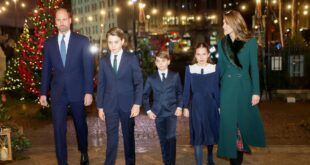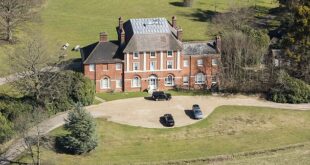Here’s the good news about the new six-part docuseries about Prince Harry and his wife Meghan, the Duchess of Sussex: If you already have Netflix, you don’t have to pay anything extra for it. And if you don’t, you can always find someone else’s password to use.
The first three hourlong episodes were released last week, and as you might expect from a production made by the prince and duchess’ own company, it’s a vanity project that shows the couple in the most glowing light — even at their worst moments, as when Harry famously donned a Nazi uniform for a costume party when he was 20. (“It was one of the biggest mistakes of my life. I felt so ashamed afterwards,” said Harry, whose penance took the form of a meeting with a rabbi and a Holocaust survivor. A forgivable sin, I’d say. It’s not like he was hanging around with a pedophile like his Uncle Andrew did.)
What’s curious about “Harry and Meghan,” as has been noted repeatedly in a spate of negative reviews, is that there is absolutely nothing new in the piece, directed by Liz Garbus. Yes, there are lots of hitherto-unseen photographs, videos, lovey-dovey texts and sweet moments with baby Archie, but the series essentially rehashes everything the couple has already revealed in previous interviews: Harry was deeply traumatized by the death of his mother and blames paparazzi for making the family’s life hell, and despite her worldliness, Meghan was woefully unprepared for the scrutiny and cruelty of the U.K. tabloid press and the chilliness of her new family. During her first “amazing” Christmas with the Windsors at Sandringham Estate, she called her mother to say she’d finally gotten to be part of the big family she’d always wanted. (Careful what you wish for.)
In their view, Harry and Meghan relinquished their official roles and moved to Montecito as a survival tactic. They still live like royalty, but in a warmer place with hummingbirds, and the ability to speak their minds. Who are we to quibble?
Just as Diana before her, Meghan, an American outsider, was expected to breathe new life into the musty royal family, whose deal with its millions of subjects can be boiled down to four words: “We pay. You pose.”
There was something historic at play as well. The once-overwhelmingly-white U.K. has become much more ethnically diverse over the past few decades. And here, a biracial woman was marrying into its most important family, which was conspicuously white.
“Could this be, in essence, a moment where the royal family caught up with the rest of Britain?” mused David Olusoga, a biracial historian and author of “Black and British.”
Nope.
Instead, it was Diana redux, with a toxic helping of racism thrown into the mix.
And yet, given the miserable experience of his mother, how is it possible that the son of Princess Diana did not instruct his beloved in the ways of the royal court? Why did he not tell her until moments before she met his grandmother, Queen Elizabeth, that she’d be expected to curtsy? In the docuseries, Meghan says she thought it was a joke when Harry asked if she knew how.
And how is it that Harry did not inform Meghan it might be considered off-putting to greet her future brother-in-law and his wife for dinner in jeans and bare feet, and with hugs?
Being herself — her bubbly, demonstrative, professionally successful, American biracial self — was never going to cut it in a family famous for its sclerotic emotional affect. She was told, for instance, never to smile at paparazzi because, Harry said, if you’re smiling it means you love it. She was told to stay silent in the face of unfair attacks. And so the cascade of racist headlines and columns went unanswered. Meghan was never going to win.
The Daily Mail’s infamous headline that Meghan was “straight outta Compton” was one of the worst examples. But the right-wing publication was a frequent offender. Meghan brought “rich and exotic DNA” to the royal family, wrote Daily Mail columnist Rachel Johnson: “Miss Markle’s mother is a dreadlocked African-American lady from the wrong side of the tracks.” Ugh.
“Yes, they’re joyfully in love,” wrote Sarah Vine, another Daily Mail columnist. “So why do I have a niggling worry about this engagement picture?” The paper soon found itself defending its use of the word “niggling,” which has nothing to do with race, but come on now.
And then there was the just plain meanness: “Don’t use the Monarchy as a MeToo soapbox, Meghan,” admonished the Daily Mail after she mentioned the movement, and the importance of women’s voices, onstage at a Royal Foundation Forum event with Prince William and Kate.
Throughout the series, context is provided by good Sussex-friendly voices, including Meghan’s mother, Doria Ragland, a former social worker and yoga teacher who lives in Los Angeles and has never until now spoken at length publicly about her daughter and son-in-law.
“This is about race,” Ragland says she told her daughter early on when Meghan was befuddled by the negativity directed her way.
“The British tabloid press exists not just as a series of publications, but also as a mentality, and it’s toxic,” explained Olusoga. It’s also an overwhelmingly white industry, he notes, “so people who come up with these headlines, they’re doing so in a newsroom that’s almost entirely white.”
So far, nothing here lands with the shock of their interview with Oprah Winfrey, in which they discussed a royal family member who, when Meghan was pregnant, speculated about what color the couple’s child’s skin would be.
Netflix has three more hours of this docuseries to air. There’s more good news though: You don’t have to watch.



